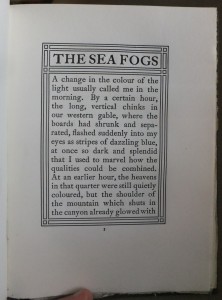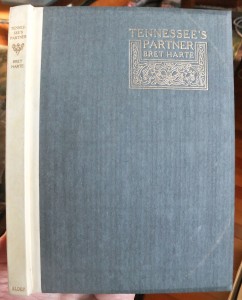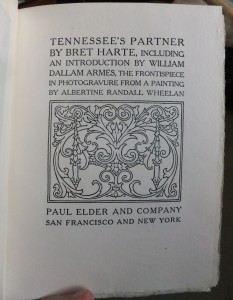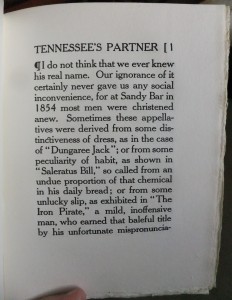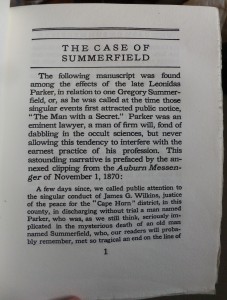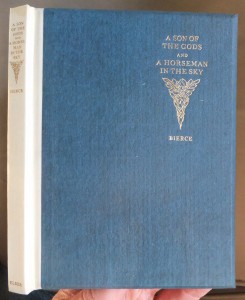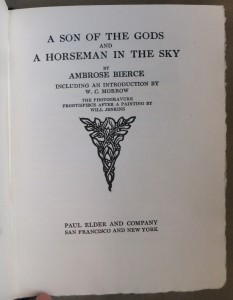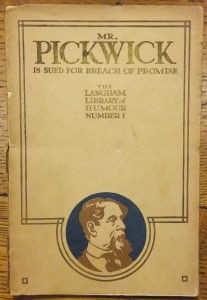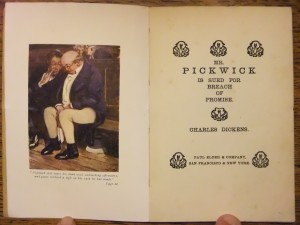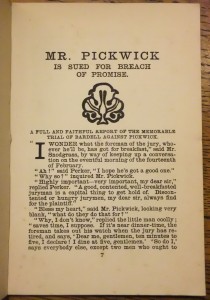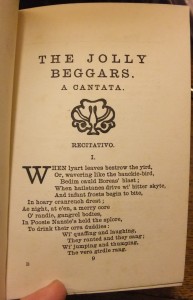
Paul Elder & Company is not generally known for “fine press,” but the 1907 series The Western Classics certainly qualifies. In my opinion, these are the highest-quality books that Paul Elder ever published. The set consists of four novels printed on fine Italian paper, high-quality bindings and handsome slipcases, each in a limited edition of 1000. The format is the consistent, but each book has its own design and is set in a different typeface.
The Sea Fogs

Robert Louis Stevenson’s Sea Fogs is an excerpted chapter from his larger work, The Silverado Squatters, published in 1883 in Edinburgh, Scotland by Chatto and Windus. The “sea fogs” of the title refers to the morning fog bank visible from Stevenson’s cabin in the hills above Calistoga, in California’s Napa Valley:
The sun was still concealed below the opposite hilltops, though it was shining already, not twenty feet above my head, on our own mountain slope. But the scene, beyond a few near features, was entirely changed. Napa valley was gone; gone were all the lower slopes and woody foothills of the range; and in their place, not a thousand feet below me, rolled a great level ocean. It was as though I had gone to bed the night before, safe in a nook of inland mountains, and had awakened in a bay upon the coast. I had seen these inundations from below; at Calistoga I had risen and gone abroad in the early morning, coughing and sneezing, under fathoms on fathoms of gray sea vapour, like a cloudy sky—a dull sight for the artist, and a painful experience for the invalid. But to sit aloft one’s self in the pure air and under the unclouded dome of heaven, and thus look down on the submergence of the valley, was strangely different and even delightful to the eyes. Far away were hilltops like little islands. Nearer, a smoky surf beat about the foot of precipices and poured into all the coves of these rough mountains. The colour of that fog ocean was a thing never to be forgotten. For an instant, among the Hebrides and just about sundown, I have seen something like it on the sea itself. But the white was not so opaline; nor was there, what surprisingly increased the effect, that breathless, crystal stillness over all. Even in its gentlest moods the salt sea travails, moaning among the weeds or lisping on the sand; but that vast fog ocean lay in a trance of silence, nor did the sweet air of the morning tremble with a sound.
Tennessee’s Partner
The popularity of Bret Harte (1836-1902) rests on his stories of the Gold Rush in California. Tennesee’s Partner first appeared in the October 1869 issue of the Overland Monthly, a magazine which Harte himself edited and published.
In 1955, RKO released the film Tennessee’s Partner, starring John Payne, Rhonda Fleming, and future California governor and US President Ronald Reagan. The movie took substantial liberties with Bret Harte’s story line.
The Case of Summerfield
William Henry Rhodes (1822–1876) is known today primarily for this one story, published in 1871 in the Sacramento Union newspaper under the pseudonym “Caxton.” The chief antagonist in the story is named “Black Bart,” an alias adopted later by the “gentleman” stagecoach bandit Charles Bolles. At the time it was published, however, The Case of Summerfield was known more for Black Bart’s ability to use potassium to set water on fire. Many consider it one of the first American science fiction stories.
A Son Of the Gods and A Horseman In the Sky
The scene of these two short stories by Ambrose Bierce (1842-1913?) is the American Civil War. This was a subject he knew all too well: Bierce joined the 9th Indiana Infantry Regiment when he was just nineteen years old, and fought in the 1861 Western Virginia campaign. Bierce later was a horrified participant at Shiloh in April 1862, an experience that would serve as the basis for many of his later short stories. Both stories first appeared in the San Francisco Examiner newspaper (29 July 1888 and 14 April 1889, respectively).
